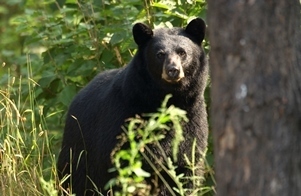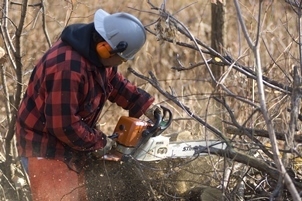|
|
|
|
News Digest - Week of May 14, 2018

|
 The DNR uses many methods to monitor Michigan wildlife populations, and two of the more interesting wildlife surveys – involving a bird’s intricate aerial dance and snagging bear hair – are taking place across northern Michigan in May.
The American Woodcock Singing-Ground Survey is performed annually across much of the northern United States, giving wildlife agencies an idea of this migratory bird’s breeding populations.
Woodcock return to northern locations like Michigan – a national leader for the number of young woodcock produced each year – from their winter homes in southern Gulf Coast states to find a mate and breed. Spring, when their unique breeding behavior can be seen and heard in the evenings, is the perfect time to count them. Just after sunset, males can be found in their singing grounds, or grassy openings, making a nasal, insect-like call known as a “peent” every four to five seconds and performing their spiral display flights.The singing-ground survey is performed annually along more than a hundred 3.6-mile survey routes.
For the bear hair snare survey, locations across the northern Lower Peninsula are baited with bacon and donuts and surrounded by barbed wire. In order to reach the bait, a bear will cross the barbed wire and snag hairs, leaving a DNA sample behind. DNR staffers will visit 257 baited locations six times starting the week of May 27 to collect snagged bear hair and send it to the DNR Wildlife Disease Lab for analysis, which will assist with future bear population estimates.
Results from both surveys will help to determine harvest regulations for future hunting seasons. Read more about the woodcock and bear surveys.
For more information, contact Katie Keen at 989-385-0336.
|
 We’re in the midst of our spring fish-stocking season, so you may be seeing DNR trucks releasing their prized cargo at hundreds of lakes and streams throughout the state.
Fish stocking is a valuable tool used by fisheries managers to restore, enhance and create new fishing opportunities in Michigan’s inland lakes, streams and the Great Lakes. he DNR accomplishes this by rearing fish at its six fish production facilities located throughout the state, cooperatively managing nearly 40 rearing ponds and six Great Lakes imprinting net pen locations, and maintaining a fleet of 18 specialized fish-stocking vehicles.
Over the course of a typical year, upwards of 20 million fish (weighing nearly 350 tons, including eight species of trout and salmon and three cool-water strains of walleye and muskellunge) are stocked. Beginning in mid-March and ending in early June, the DNR fish-stocking trucks will travel well over 100,000 miles to visit between 700 and 1,100 locations.
For more information on fish-stocking efforts, visit michigandnr.com/fishstock/ or contact Steve VanDerLaan, 269-668-2696, ext. 26.
|
 One of the state’s most distinctive signs of a new season is on its way – the brightly colored monarch butterfly. A well-known and beloved butterfly species in North America, monarchs, unfortunately, have become a much less common sight in recent decades.
The eastern monarch butterfly population has declined by more than 80 percent over the last 20 years, primarily from habitat loss, both in their summer range – including Michigan – and in Mexico, where they spend the winter.
“Adult monarch butterflies require a variety of flowering plants for nectar,” said Hannah Schauer, wildlife communications coordinator with the DNR. “Grasslands provide a mix of plant species that pollinators, like the monarch, need – with both early- and late-blooming plants and those that flower mid-summer.”
Monarchs returning to Michigan will depend on these early-blooming plants to refuel and build up their energy, so they can lay eggs for the next generation.
Grasslands also support milkweeds, vital to the monarch’s reproductive cycle because they’re the only species of plants that monarch caterpillars eat. Milkweeds also provide food resources for other animals.
A backyard garden can provide important habitat for pollinators, too, so consider these tips as you plan for this year’s garden. When you do start spotting monarchs, be sure to report those sightings because it helps inform conservation decisions here in Michigan. Report sightings and track their migration at Journey North.
Related, the Midwest Association of Fish and Wildlife Agencies recently shared a new draft plan aimed at reversing the decline of the eastern monarch butterfly population and is welcoming public review and comment on it.
Find out more about ways you can help monarchs in Michigan by visiting michigan.gov/monarchs or contacting Hannah Schauer at 517-388-9678.
|
 Willing to work for your warmth this winter? Apply now for a fuelwood permit from the Michigan Department of Natural Resources.
Where can you cut? A new, interactive map highlights state forest areas in the northern Lower Peninsula where Michigan residents are allowed to collect up to five standard cords of wood from downed, dead trees. Upper Peninsula residents also may get fuelwood permits from their local state forest management unit offices.
“The new map will help people who want to cut wood decide where to go,” said Deb Begalle, chief of the DNR’s Forest Resources Division. “Then we encourage people to visit potential collection areas to determine what wood is down and available.”
You can obtain a permit in two ways: Visit a DNR office in person or download a mail-in permit order at michigan.gov/fuelwood. The site also includes the interactive map and a map of DNR offices that offer fuelwood permits.
Permits cost $20 each and are good for 90 days. All permits expire Dec. 31, 2018. The department issues as many as 3,500 fuelwood permits each year. Wood cut on a fuelwood permit is intended for personal use and cannot be sold.
To help prevent the spread of invasive species such as the emerald ash borer or oak wilt, the DNR advises against moving firewood around the state. Learn more about firewood rules and recommendations on the Michigan Department of Agriculture’s website.
For more information, contact Doug Heym, 517-284-5867.
|
 As temperatures start to warm across much of the state, many anglers are looking forward to fishing the open-water season. It’s a good time for a reminder that all bass fishing tournaments in Michigan are required to be registered with and report their results to the DNR.
“We’ve been requiring bass fishing tournaments to register and report with us since 2016,” said DNR fisheries biologist Tom Goniea. “The results we received during the first two years have been very informative, as approximately 2,200 tournaments were registered in each of the last two years on 275 of Michigan’s lakes and rivers. Those reports provided valuable data on the state’s bass fisheries.”
The data collected is used to better understand and promote Michigan’s bass fishery and tournament fishing’s role in state fishing and tourism. The information also guides future management discussions about fishing seasons and additional opportunities.
“If they haven’t done so already, tournament directors should get online and register their 2018 tournaments,” said Goniea. “So far in 2018, more than 1,869 tournaments have already registered and more are coming in every day.”
Tournaments must be registered and report online using the DNR’s Michigan Fishing Tournament Information System, available at michigan.gov/fishingtournaments. For more information, contact Tom Goniea, 517-284-5830.
|
PHOTOS AVAILABLE: News editors interested in photos to accompany these stories can get them in this photo folder. Images include:
- A black bear.
- A DNR fish-stocking truck.
- People bass fishing from a boat.
- A monarch butterfly on milkweed.
- A man cutting downed trees for fuelwood.
|
|
|
|
|
|
|
MANAGE SUBSCRIPTIONS | UNSUBSCRIBE ALL | CONTACT US | FEEDBACK | HELP
|
|
|